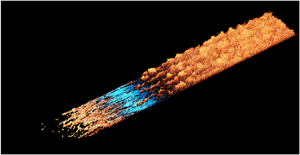Crossref Citations
This article has been cited by the following publications. This list is generated based on data provided by
Crossref.
Griffin, Kevin Patrick
Fu, Lin
and
Moin, Parviz
2021.
General method for determining the boundary layer thickness in nonequilibrium flows.
Physical Review Fluids,
Vol. 6,
Issue. 2,
Martínez-Ruiz, D.
Huete, C.
Martínez-Ferrer, P. J.
and
Mira, D.
2021.
Specific heat effects in two-dimensional shock refractions.
Shock Waves,
Vol. 31,
Issue. 1,
p.
1.
Volpiani, P. S.
2021.
Numerical strategy to perform direct numerical simulations of hypersonic shock/boundary-layer interaction in chemical nonequilibrium.
Shock Waves,
Vol. 31,
Issue. 4,
p.
361.
Huete, C.
Cuadra, A.
Vera, M.
and
Urzay, J.
2021.
Thermochemical effects on hypersonic shock waves interacting with weak turbulence.
Physics of Fluids,
Vol. 33,
Issue. 8,
Goc, Konrad A.
Lehmkuhl, Oriol
Park, George Ilhwan
Bose, Sanjeeb T.
and
Moin, Parviz
2021.
Large eddy simulation of aircraft at affordable cost: a milestone in computational fluid dynamics.
Flow,
Vol. 1,
Issue. ,
Zhao, XiaoJian
Hu, Haiyang
and
Zhao, Lei
2021.
Effect of an adverse pressure gradient on hypersonic wall pressure fluctuations.
Physics of Fluids,
Vol. 33,
Issue. 10,
Di Renzo, M.
and
Urzay, J.
2021.
Direct numerical simulation of a hypersonic transitional boundary layer at suborbital enthalpies.
Journal of Fluid Mechanics,
Vol. 912,
Issue. ,
Griffin, Kevin Patrick
Fu, Lin
and
Moin, Parviz
2021.
Velocity transformation for compressible wall-bounded turbulent flows with and without heat transfer.
Proceedings of the National Academy of Sciences,
Vol. 118,
Issue. 34,
Fu, Lin
2021.
Very-high-order TENO schemes with adaptive accuracy order and adaptive dissipation control.
Computer Methods in Applied Mechanics and Engineering,
Vol. 387,
Issue. ,
p.
114193.
Cao, Shibin
Hao, Jiaao
Klioutchnikov, Igor
Wen, Chih-Yung
Olivier, Herbert
and
Heufer, Karl Alexander
2022.
Transition to turbulence in hypersonic flow over a compression ramp due to intrinsic instability.
Journal of Fluid Mechanics,
Vol. 941,
Issue. ,
Chang, Eric Won Keun
Chan, Wilson Y.K.
McIntyre, Timothy J.
and
Veeraragavan, Ananthanarayanan
2022.
Hypersonic shock impingement studies on a flat plate: flow separation of laminar boundary layers.
Journal of Fluid Mechanics,
Vol. 951,
Issue. ,
Bai, Tianyi
Griffin, Kevin P.
and
Fu, Lin
2022.
Compressible Velocity Transformations for Various Noncanonical Wall-Bounded Turbulent Flows.
AIAA Journal,
Vol. 60,
Issue. 7,
p.
4325.
Agrawal, Rahul
Whitmore, Michael P.
Griffin, Kevin P.
Bose, Sanjeeb T.
and
Moin, Parviz
2022.
Non-Boussinesq subgrid-scale model with dynamic tensorial coefficients.
Physical Review Fluids,
Vol. 7,
Issue. 7,
Arranz, Gonzalo
and
Lozano-Duran, Adrian
2022.
Assessment of information-theoretic-based control of turbulent flow separation of an aircraft in stall.
Cheng, Cheng
Shyy, Wei
and
Fu, Lin
2022.
Streamwise inclination angle of wall-attached eddies in turbulent channel flows.
Journal of Fluid Mechanics,
Vol. 946,
Issue. ,
Goc, Konrad
Bose, Sanjeeb T.
and
Moin, Parviz
2022.
Large Eddy Simulation of the NASA High-Lift Common Research Model.
Ji, Zhe
Liang, Tian
and
Fu, Lin
2022.
A Class of New High-order Finite-Volume TENO Schemes for Hyperbolic Conservation Laws with Unstructured Meshes.
Journal of Scientific Computing,
Vol. 92,
Issue. 2,
Williams, Emily
and
Lozano-Duran, Adrian
2022.
Information-Theoretic Approach for Subgrid-Scale Modeling for High-Speed Compressible Wall Turbulence.
Fu, Lin
2022.
An Efficient Low-Dissipation High-Order TENO Scheme for MHD Flows.
Journal of Scientific Computing,
Vol. 90,
Issue. 1,
Chen, Peng E. S.
Lv, Yu
Xu, Haosen H. A.
Shi, Yipeng
and
Yang, Xiang I. A.
2022.
LES wall modeling for heat transfer at high speeds.
Physical Review Fluids,
Vol. 7,
Issue. 1,

 $\pm 10\,\%$ at a computational cost lower than DNS by two orders of magnitude. Downstream of the interaction, in the turbulent boundary layer, the WMLES agrees well with DNS results for the Reynolds analogy factor, the mean profiles of velocity and temperature, including the temperature peak, and the temperature/velocity correlation.
$\pm 10\,\%$ at a computational cost lower than DNS by two orders of magnitude. Downstream of the interaction, in the turbulent boundary layer, the WMLES agrees well with DNS results for the Reynolds analogy factor, the mean profiles of velocity and temperature, including the temperature peak, and the temperature/velocity correlation.